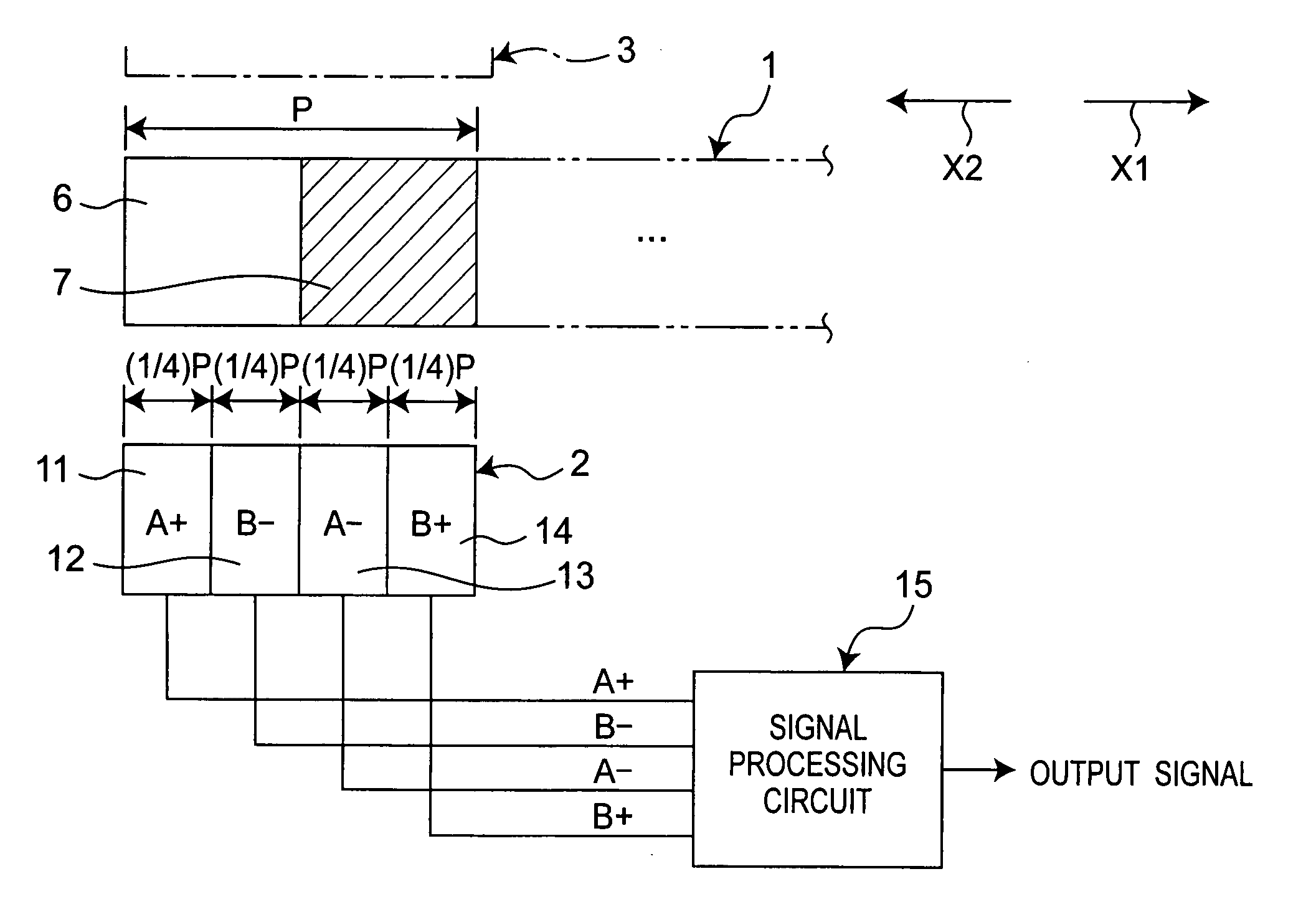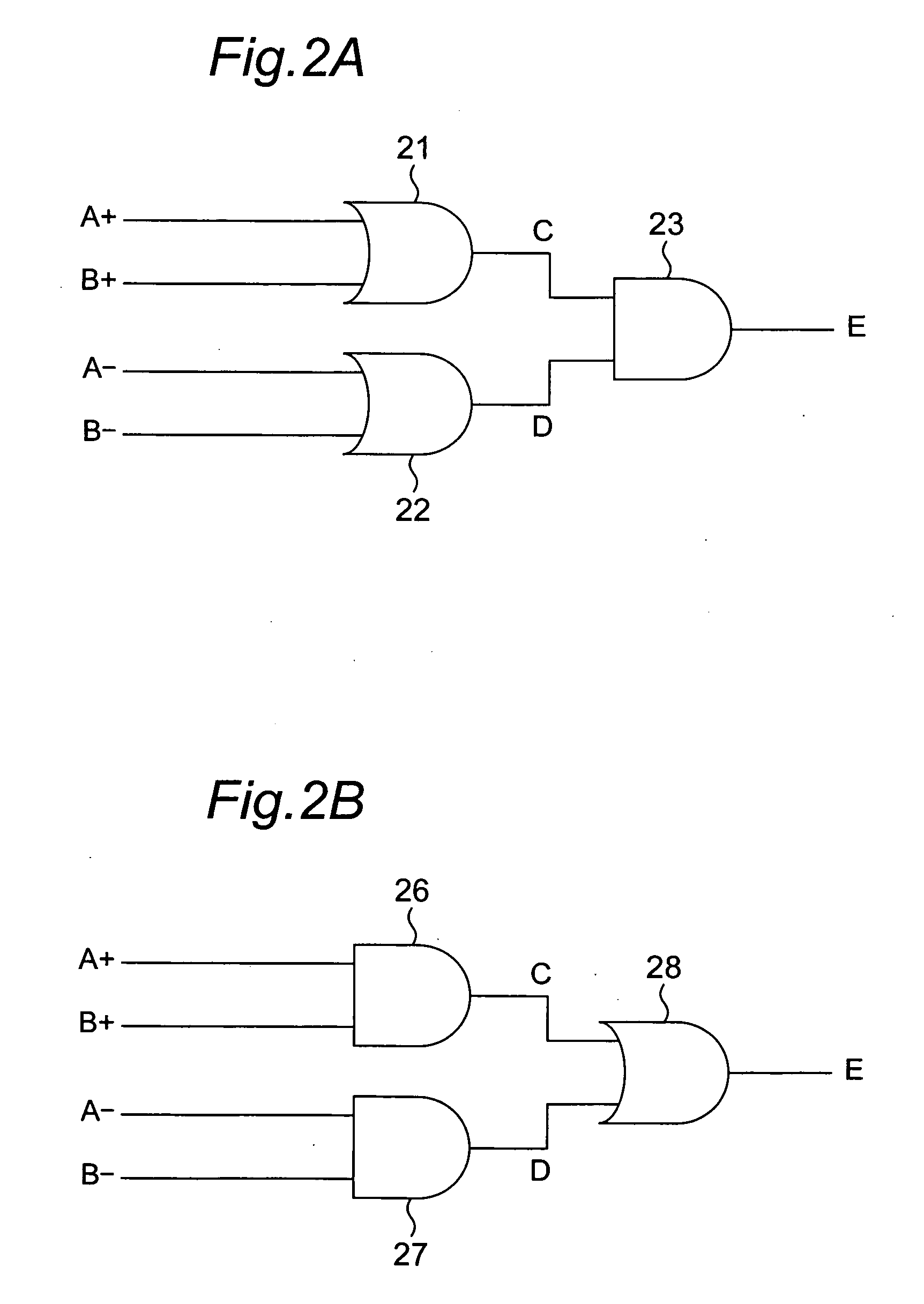Optical encoder and electronic equipment having the same
a technology of optical encoder and electronic equipment, applied in the direction of discharge tube/lamp details, instruments, material analysis, etc., can solve the problems of varying the duty ratio of output signals, affecting the accuracy of output signals, and inevitably occurring a 1-gate delay in logic circuits
- Summary
- Abstract
- Description
- Claims
- Application Information
AI Technical Summary
Benefits of technology
Problems solved by technology
Method used
Image
Examples
first embodiment
[0059]FIG. 1 shows an outlined configuration of a first embodiment of the optical encoder of the invention. The first embodiment includes a mover 1, a light receiving section 2 and a light emitting section 3. The light emitting section 3 is composed of light emitting elements such as LEDs (light emitting diodes).
[0060]The light receiving section 2 has four light receiving elements 11-14. For higher resolutions, the light receiving section 2 may also include a larger number, such as 8 or 16, of light receiving elements arranged therein. The mover 1 is movable in a direction indicated by arrow X1 or X2, where light-on portions 6 and light-off portions 7 are alternately arrayed along the moving direction. Given an array pitch P of the light-on portions 6, each of the light-on portions 6 and the light-off portions 7 has a size in the moving direction (width) equal to (½)P. The light-on portions 6 transmit light derived from the light emitting section 3 toward the light receiving section...
second embodiment
[0068]Next, FIG. 2B shows a structure of a signal processing circuit included in a second embodiment of the optical encoder of the invention. This second embodiment differs from the foregoing first embodiment only in that a signal processing circuit shown in FIG. 2B is provided instead of the signal processing circuit shown in FIG. 2A of the first embodiment. Therefore, differences from the first embodiment will mostly be described in this second embodiment.
[0069]The signal processing circuit included in the second embodiment, as shown in FIG. 2B, has a first AND circuit 26, a second AND circuit 27, and an OR circuit 28. Inputted to the first AND circuit 26 are light reception signals A+ and B++which are different in phase by 90° from each other. Also, inputted to the second AND circuit 27 are light reception signals A− and B− which are different in phase by 90° from each other.
[0070]Therefore, the first AND circuit 26 computes a logical AND of the light reception signal A+ and the ...
third embodiment
[0093]Next, FIG. 7 shows a structure of a signal processing circuit included in a third embodiment of the optical encoder of the invention. This third embodiment differs from the foregoing first embodiment only in that a signal processing circuit shown in FIG. 7 is provided instead of the signal processing circuit shown in FIG. 2A of the first embodiment. Therefore, differences from the first embodiment will mostly be described in this third embodiment.
[0094]The signal processing circuit included in this third embodiment, as shown in FIG. 7, has first to fourth inverters 81-84, a fifth inverter 85 to which outputs of the first, second inverters 81, 82 are inputted, and a sixth inverter 86 to which outputs of the third, fourth inverters 83, 84 are inputted. The signal processing circuit also has a seventh inverter 87 to which outputs of the fifth, sixth inverters 85, 86 are inputted, and an eighth inverter 88 to which an output of the seventh inverter 87 is inputted.
[0095]The signal ...
PUM
 Login to View More
Login to View More Abstract
Description
Claims
Application Information
 Login to View More
Login to View More - R&D
- Intellectual Property
- Life Sciences
- Materials
- Tech Scout
- Unparalleled Data Quality
- Higher Quality Content
- 60% Fewer Hallucinations
Browse by: Latest US Patents, China's latest patents, Technical Efficacy Thesaurus, Application Domain, Technology Topic, Popular Technical Reports.
© 2025 PatSnap. All rights reserved.Legal|Privacy policy|Modern Slavery Act Transparency Statement|Sitemap|About US| Contact US: help@patsnap.com



